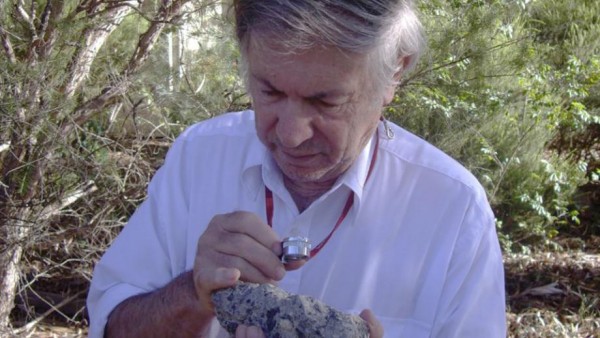'World's Largest Asteroid Impact Crater' is Secretly Hidden in Australia
| Ana Verayo | | Mar 24, 2015 03:51 AM EDT |
(Photo : D. Seymour/ANU) Andrew Glikson with a sample of suevite, a rock with partially melted material formed during an impact.
Scientists have uncovered the world's largest asteroid crash site based on geological evidence hidden beneath Australian soil.
A new study revealed that some 300 million to 600 million years ago, a gigantic asteroid was split into two before it smashed into the Earth. This impact of apocalyptic proportions created two large craters that extended more than 250 miles across when combined, an area is larger than the state of Missouri.
Like Us on Facebook
Study lead author Andrew Glikson, a paleoclimate scientist from the Australian National University, said the two asteroids probably measured 6.2 miles across.
These impact sites are unlike the Meteor Crater in Arizona since they're hidden underground. These prehistoric craters were erased into obscurity by geological processes.
The craters, however, formed "domes" underneath the Earth's crust when the rock rebounded from the impact, and the ground up lifted from the mantle, said Glikson.
Glikson and his team saw clues of these domes while they were excavating and drilling into the Earth's crust as part of a geothermal research project in Australia's Warburton Basin.
After drilling more than 1.25 miles beneath the surface, they discovered traces of rocks that were melted into glass, a process that occurred during the catastrophic asteroid impact. Using magnetic models, the scientists then found iron and magnesium rich domes underground.
Researchers are still uncovering clues that could tell them how the actual impact looked like. They're still determining when the crash happened and are searching for the corresponding layer of sediments that would have resulted from the impact.
This newly discovered impact zone underneath the Warburton Basin is now the largest known impact crater on the planet, ahead of the Vredefort crater found in South Africa which was originally 185 miles across.
The Vredefort crater is still the oldest known impact crater on Earth and scientists believe it was created some 2.02 billion years ago.
Tags'Largest Asteroid Impact Crater in the World' is Secretly Hidden in Australia, Australia, warburton basin, asteroid impact zone australia, biggest asteroid crater in the world, asteroid crater impact zone
©2015 Chinatopix All rights reserved. Do not reproduce without permission
EDITOR'S PICKS
-

Did the Trump administration just announce plans for a trade war with ‘hostile’ China and Russia?
-

US Senate passes Taiwan travel bill slammed by China
-

As Yan Sihong’s family grieves, here are other Chinese students who went missing abroad. Some have never been found
-

Beijing blasts Western critics who ‘smear China’ with the term sharp power
-

China Envoy Seeks to Defuse Tensions With U.S. as a Trade War Brews
-

Singapore's Deputy PM Provides Bitcoin Vote of Confidence Amid China's Blanket Bans
-

China warns investors over risks in overseas virtual currency trading
-

Chinese government most trustworthy: survey
-

Kashima Antlers On Course For Back-To-Back Titles
MOST POPULAR
LATEST NEWS
Zhou Yongkang: China's Former Security Chief Sentenced to Life in Prison

China's former Chief of the Ministry of Public Security, Zhou Yongkang, has been given a life sentence after he was found guilty of abusing his office, bribery and deliberately ... Full Article
TRENDING STORY

China Pork Prices Expected to Stabilize As The Supplies Recover

Elephone P9000 Smartphone is now on Sale on Amazon India

There's a Big Chance Cliffhangers Won't Still Be Resolved When Grey's Anatomy Season 13 Returns

Supreme Court Ruled on Samsung vs Apple Dispute for Patent Infringement

Microsoft Surface Pro 5 Rumors and Release Date: What is the Latest?










